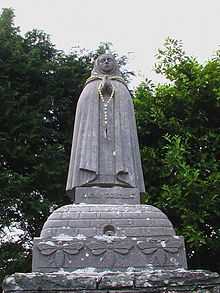Gobnait
| Saint Gobnait | |
|---|---|
 Saint Gobnait | |
| Born | fl 6th century |
| Feast | 11 February |
| Patronage | bees |
Saint Gobnait (fl. 6th century?), also known as Gobnat or Mo Gobnat, is the name of a medieval, female Irish saint whose church was Móin Mór, now Bairnech, in the village of Ballyvourney (Irish: Baile Bhuirne), County Cork in Ireland.[1] She was associated with the Múscraige and her church and nunnery lay on the borders between the Múscraige Mittine and Eóganacht Locha Léin.[1] Her feast day is 11 February.
Sources
No hagiographical Life is known to have described her life and miracles, but she appears in the Life of her senior companion St Abbán moccu Corbmaic,[1] written in the early 13th century but known only through later recensions. Saint Finbarr's Life implies that Gobnait's church belonged to Finbarr's foundation at Cork by alleging that it was not founded by her, but by one of his disciples.[1] In spite of this, Gobnait's cult continued to thrive here and the ruins of a medieval church dedicated to her are still visible today.[1]
The Félire Óengusso and the Martyrology of Donegal give her feast-day on 11 February.[1]
| "Mo Gobnat from Muscraige Mitaine, i.e. a sharp-beaked nun, |
| Ernaide is the name of the place in which she is. |
| Or Gobnat of Bairnech in Món Mór in the south of Ireland, |
| and of the race of Conaire she is; a virgin of Conaire's race" |
| –Note to the Félire Óengusso, tr. Whitley Stokes, p. 73 |
Life
Gobnait was born in County Clare in the 5th or 6th Century, and is said to have been the sister of Saint Abban. She fled a family feud, taking refuge at Inisheer in the Aran Islands.[2] Here an angel appeared and told her that this was "not the place of her resurrection" and that she should look for a place where she would find nine white deer grazing. She found the deer at the placenow known as St. Gobnet's Wood. Saint Abban is said to have worked with her on the foundation of the convent and to have placed Saint Gobnait over it as abbess.
Celtic lore held bees in high esteem believing the soul left the body as a bee or a butterfly. Gobnait added beekeeping to her life's work developing a lifelong affinity with them. She started a religious order and dedicated her days to helping the sick, probably using honey as a healing aid.[3] St Gobnait had a particular skill in caring for the sick and she is credited with saving the people at Ballyvourney from the plague.[2]
Legends
One story tells of how she drove off a brigand by sending a swarm of bees after him and making him restore the cattle he had stolen.[2]
Well
St Gobnait's well (also known as St Debora, Deriola or Abigails well) is situated to the North of Ballyagran in a high field to the left of the road to Castletown. Rounds were made and a pattern was held on 11 February until around 1870. The well has now dried up but the site is still known. It is that a white stag could sometimes be seen at the well.[4]
Veneration
In 1601 Pope Clement VIII granted a special indulgence to those who, on Gobnait's day, visited the parish church, went to Confession and Communion and who prayed for peace among 'Christian princes', expulsion of heresy and the exaltation of the church.[5]
The saint is still locally venerated today,[1] and is among a group of Irish saints whose feast day has been given national rather than just local recognition. The main centres of devotion to Gobnait are Inis Oírr (Aran Islands), Dún Chaoin in West Kerry and Balleyvourney near the Cork / Kerry border.[5] She is depicted on a stained glass window at Honan Chapel in Cork, which was made by artist Harry Clarke in 1916.[6]
Legacy
There are a number of places which carry her name such as Kilgobnet or Cill Ghobnait, near Dungarvan and Milltown in Co. Kerry.[5]
Notes
- ↑ 1.0 1.1 1.2 1.3 1.4 1.5 1.6 Johnston, "Munster, saints of (act. c.450–c.700)."
- ↑ 2.0 2.1 2.2 "A Gathering of Irish Saints", AOH division 61, Philadelphia
- ↑ Nolan, Mark, "St. Gobnait's Day", Enfield Beekeepers
- ↑ "Holy Wells", Limerick Diocese Heritage
- ↑ 5.0 5.1 5.2 Diocese of Kerry, St Gobnait.
- ↑ Bowe, "Wilhelmina Geddes", p. 83.
See also
References
- Félire Óengusso ("The Martyrology of Óengus"), ed. and tr. Whitley Stokes (1905). The Martyrology of Oengus the Culdee. Henry Bradshaw Society 29. London. pp. 60, 72–3 (11 February). (PDF here)
- Bowe, Nicola Gordon (1988). "Wilhelmina Geddes, Harry Clarke, and Their Part in the Arts and Crafts Movement in Ireland". The Journal of Decorative and Propaganda Arts 8: 58–79.
- Harris, Dorothy C. (1938). "Saint Gobnet, Abbess of Ballyvourney". The Journal of the Royal Society of Antiquaries of Ireland. Seventh Series 8.2: 272–7.
- Johnston, Elva. "Munster, saints of (act. c.450–c.700)." Oxford Dictionary of National Biography. Oxford University Press, Sept 2004, online edition May 200. Accessed: 14 Dec 2008.
Further reading
- O'Kelly, Michael J. (1952). "St. Gobnet's House, Ballyvourney, Co. Cork". Journal of the Cork Historical and Archaeological Society 57: 18–40.
- Ua hÉaluighthe, Diarmuid (1952). "St. Gobnet of Ballyvourney". Journal of the Cork Historical and Archaeological Society 57: 43–61.
External links
| Wikimedia Commons has media related to St Gobnait. |